Glycogen and Its Storage Sites
What is Glycogen?
Glycogen is essentially your body's way of storing carbohydrates for later use - think of it as your body's energy savings account! It's a complex polysaccharide made up of many glucose molecules linked together in branching chains.
Glycogen is specifically designed for quick access to energy, unlike fat which is more of a long-term storage solution.
The structure of glycogen is fascinating:
- It consists of glucose units connected by α-1,4 and α-1,6 glycosidic bonds
- The branching structure allows for rapid breakdown when energy is needed
- It can be quickly converted back to glucose when blood sugar levels drop
Major Storage Sites
Your body primarily stores glycogen in two main locations:
1. The Liver
- Stores approximately 100g of glycogen
- Primarily responsible for maintaining blood glucose levels
- Can break down glycogen to glucose and release it into the bloodstream
The liver's glycogen stores are particularly important for maintaining stable blood sugar levels between meals and during overnight fasting.
2. Skeletal Muscles
- Stores about 400-500g of glycogen
- Used exclusively by the muscle cells themselves


